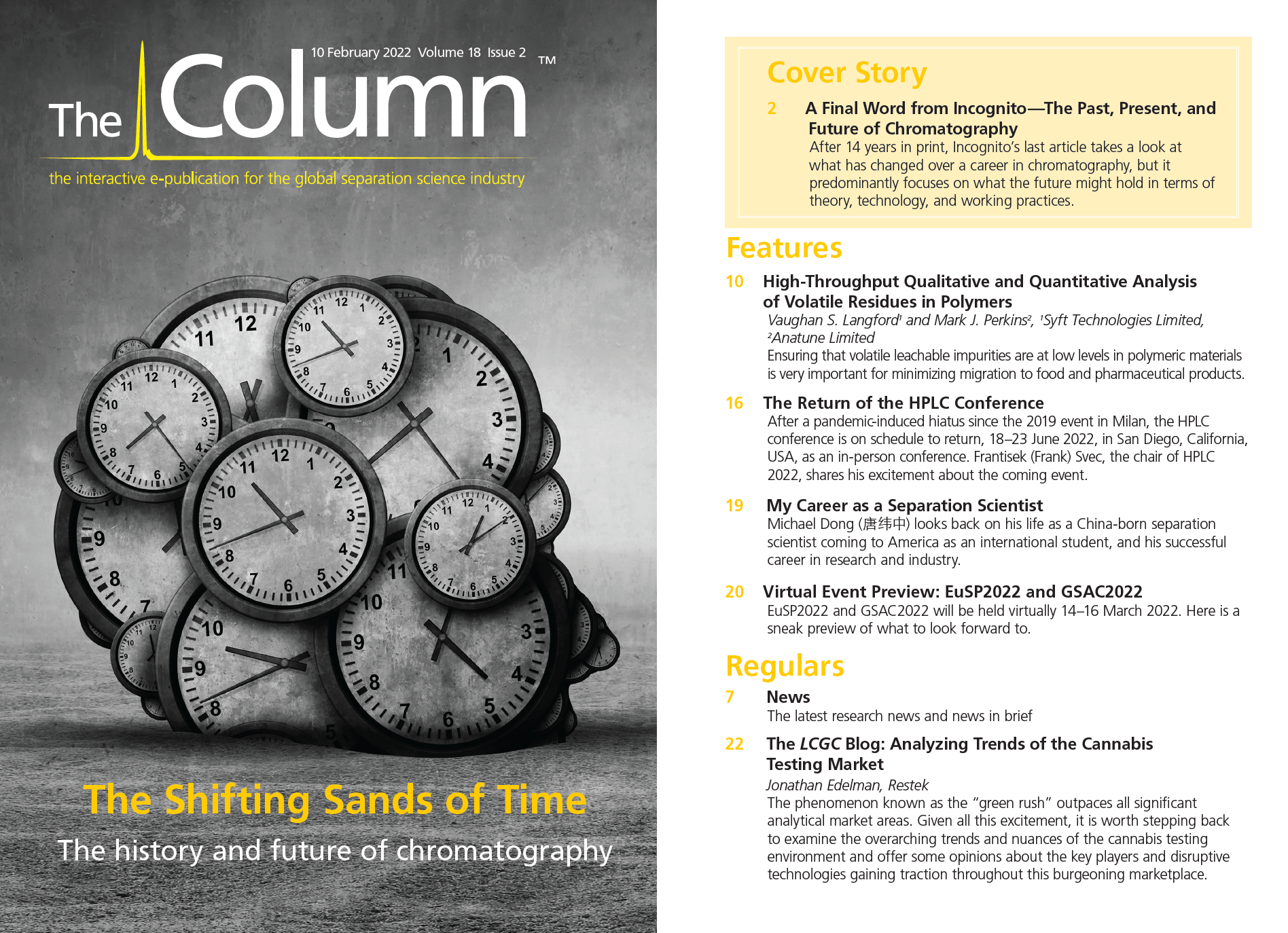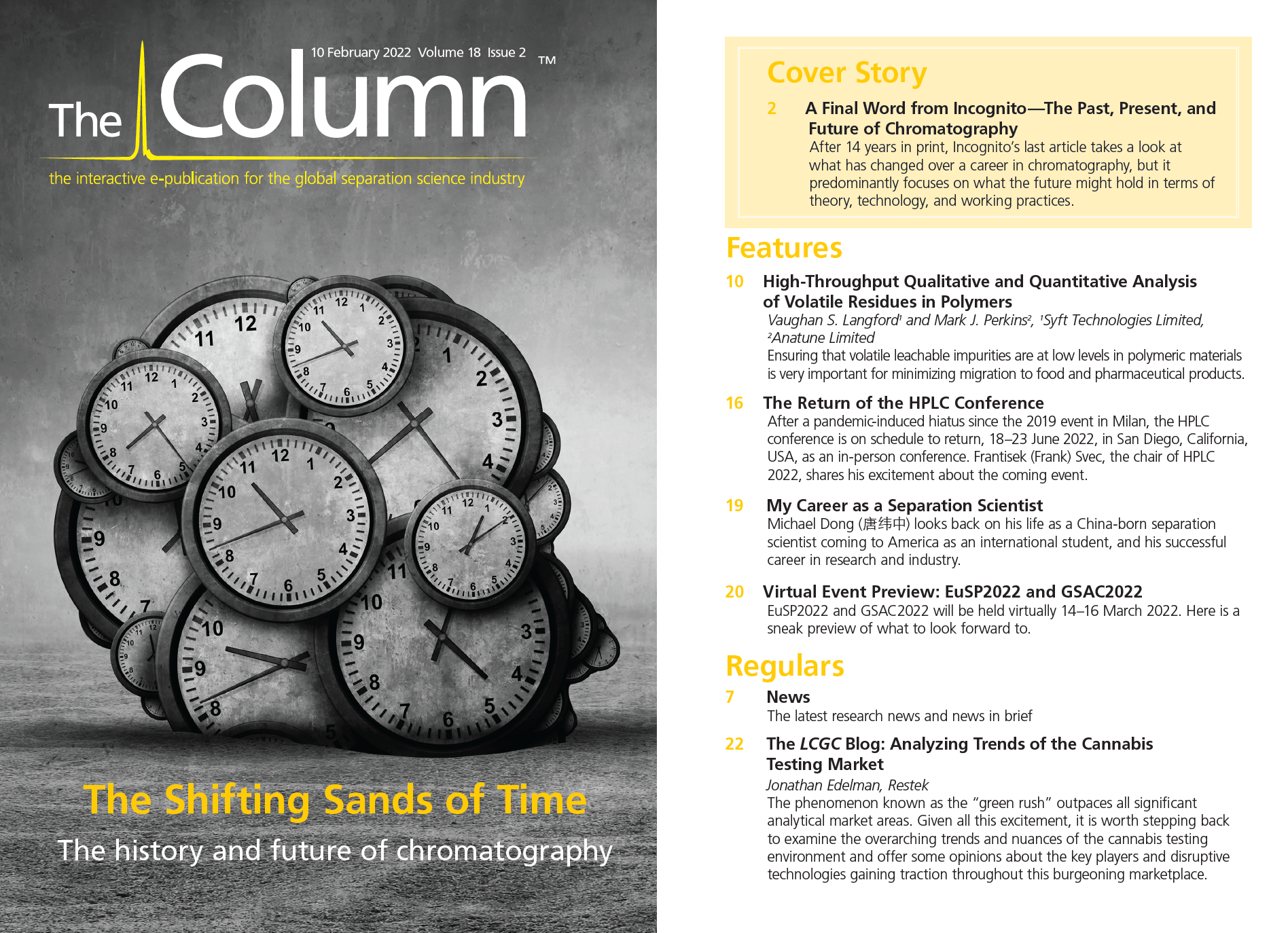The Return of the HPLC Conference
After a pandemic-induced hiatus since the 2019 event in Milan, the HPLC conference is on schedule to return, June 18–23, 2022, in San Diego, California, as an in-person conference. Frantisek (Frank) Svec, the chair of HPLC 2022, shares news about the conference and his excitement about the coming event.
What are you most excited about for the HPLC 2022 conference?
We must remember that HPLC conferences have a long tradition. The upcoming HPLC 2022 event is the 50th conference in this series. The first conference was held in 1973 in Interlaken, Switzerland; ever since, the event has alternated between Europe (in odd years) and the United States (in even years). The first Asian location was Kyoto, Japan, in 2001 and the regular biennial conferences in Asia started in 2008. The Asian events are held as the second HPLC meeting in the odd years. However, because of the Covid pandemic, the last symposium was held in Milan in 2019. Thus, between the Milan event and the upcoming 2022 conference, three years will have passed. Can you imagine what has happened during these three years? Clearly, a lot—yet nothing has been reported or discussed at any in-person conference. Also, how many new scientists entered the field of chromatography who have never been able to attend such a large symposium and meet with their peers? So, I feel really excited that we are finally (and hopefully for good) coming back to normal, to once again hold three in-person HPLC conferences every two years. The community of both old friends and newcomers will congregate again. We will see each other, shake hands, hug, talk— you name it. Isn’t that exciting?
What is new or different in this year’s program?
The HPLC 2022 program will be certainly full of new thrilling developments. Obviously, we plan to retain all the goodies of past conferences. This means we are going to have sessions concerning column technologies, sample preparation, detection with focus on mass spectrometry, chromatography theory, and a plethora of applications, to name just a few. We will see the poster competition in which young participants will demonstrate their skills in designing their presentations. The young speakers selected to compete for the traditional Csaba Horvath Award will present in the oral sessions. In addition, some other new features, mostly focused on younger attendees, are also coming. For example, the Separation Science Slam is a new competition for young scientists that highlights short scientific presentations and aims to not only inform but to engage the audience. Another new competition open for everyone is the HPLC Tube contest, where short videos related to HPLC will be presented. People contributing to both these new activities will get oral time to present their creations. But I don’t have enough space here to name everything. You can find details on our website.
One of your goals is to encourage more dialogue and collaboration between academic and industrial scientists. Can you talk more about that?
The biotechnology industry is developing rapidly these days. New highly effective biological drugs pop up like mushrooms in the forest. Monoclonal antibodies move the world. RNA has come to the forefront of our interest thanks to vaccines fighting the Covid pandemic. Thus, the biopharmaceutical industry urgently needs chromatography both in the development phase as well as during the production cycle and quality control. Therefore, it is not uncommon for company employees to participate in the symposium. Many of them will be part of the oral program and will have the opportunity to show their priorities and communicate their results. And conversely, many of the presentations by academics will relate to basic research with an impact that extends beyond the walls of university laboratories directly into industry. For instance, the development of new methods might be very useful in quality control.
What aspects of the conference will be of particular value for young scientists?
I think I have already mentioned several aspects that are designed to attract young scientists to actively participate in the symposium. In addition, the symposium program will include 15-minute presentations that will be mostly reserved for students and postdoctoral researchers. These speakers will be selected based on submitted abstracts. Also, all the competitions are attractive for the new generation and are very popular because they include an opportunity to give a talk.
There is talk in the scientific community about taking a fresh approach to poster presentations. Are you doing anything new in that regard?
Sure. The presentation of posters is developing with the development of tools available for their design and preparation. Remember the pre-PowerPoint and pre-large color printing era? What a pain it was. Posters were created from individual panels printed in-house by simple printers on letter-sized paper. Now, we create the posters in a single piece on screen and then print it in beautiful vivid colors to enhance their visual appeal. However, the options that current technology provides do not guarantee high-quality posters. Their content does.
Unfortunately, not all presenters know how to create an award-winning poster. I have seen posters crowded with small features that are difficult to see clearly even up close; these posters require way too much time to read. Another bad habit is filling the poster with excessive text. A poster should not be a manuscript attached to a board. A poster is a visual art. Thus, we plan to prepare detailed guidance for the preparation of posters and post it on the symposium website. These instructions may also include a sample template to help beginners. We are also going to advise authors to show only the most important features of their research and place a QR code on the poster to guide those interested to a page where the authors will post related information—such as experimental details, large tables, links to accepted and published papers on the topic, and even videos—that could not fit on the poster.
Does the HPLC conference have a value that is distinct from that of other conferences?
The HPLC symposia are the largest of their kind. Hundreds of attendees. An extensive exhibition. Where else you can find all this in a single place? Other conferences covering liquid-phase separations are certainly important as well, but they typically bring together only a smaller fraction of people working in the field. We have a conference where all the gurus are present and often also presenting; one can connect the name with the face, and it is even possible to talk to those colleagues during coffee breaks, at the posters, or at dinners. The large conference gives you a unique opportunity to do so. I know what I am talking about: I started as a “greenhorn” in the early 1990s and the HPLC symposia were my first door into the chromatographic community.
In today’s digital world—particularly given the many virtual events held since the start of the pandemic—do you think people need to be convinced of the value of attending an in-person scientific meeting?
The ancient Greek philosopher Aristotle wrote, in 350 B.C.E, “Man is by nature a social animal.” People need to gather and communicate. The internet is certainly a wonderful technology that often makes our lives easier (but not always). But the internet cannot replace personal encounters. Virtual events are just what they are: virtual events. Speaking to an audience you see in front of you is irreplaceable. The energy of the people there, the eye contact, the body language, the feedback. Did you ever try to tell a joke when presenting virtually? You don’t hear the attendees laugh, and they probably don’t laugh anyway. And now imagine a real, in-person audience. It’s electrifying. Thus, I do not think that people need to be convinced of the value of meeting in person. The only limiting factor can be economic—whether they can afford it. But the desire to meet in person never ceases.
What Covid safety measures will be in place for the meeting? Are you planning any online aspects of this meeting, for those who may not be able to attend in person, or who are reluctant to do so?
Unfortunately, Covid is here, so we cannot neglect measures to prevent its spreading. Clearly, it is difficult to predict what rules will apply in mid June. But no matter what, we will be careful to observe all regulations in force at the time of the symposium. I think the need for complete vaccination, including the booster shot(s), no longer needs to be emphasized. That must be taken for granted today. It is likely that everyone will have to wear a face mask all the time inside the venue except when presenting at the podium or when eating or drinking. But again, all measures will be updated as needed to meet regulations required by the CDC at the time. We deeply believe that the epidemiological situation in June will be good. That is why we are not planning any online presentations.
Putting together a large conference a lot of work. How will you judge if it was a success?
I will consider it a big success if the HPLC 2022 symposium is held in person. That by itself will be an achievement because we all know well that things can change rapidly. Then, I hope the symposium will breathe new life into the community of chromatographers—the vitality we almost lost during the last three years. I also trust that we will welcome many academic, industrial, and governmental leaders in separation science. A success will be the presence of many students and postdocs—the younger generation of chromatographers. And finally, success will also be judged by the attendees themselves. All the efforts we make should lead to a conference that the participants will remember for a long time. We have a unique opportunity to create a wonderful professional agenda framed by a strong social program in a charming city abounding in all tastes of attractions. I am looking forward to seeing many friends and colleagues in San Diego in the summer.
E-mail: janet@barrconferences.com
Website: https://hplc2022.org

Common Challenges in Nitrosamine Analysis: An LCGC International Peer Exchange
April 15th 2025A recent roundtable discussion featuring Aloka Srinivasan of Raaha, Mayank Bhanti of the United States Pharmacopeia (USP), and Amber Burch of Purisys discussed the challenges surrounding nitrosamine analysis in pharmaceuticals.
Silvia Radenkovic on Building Connections in the Scientific Community
April 11th 2025In the second part of our conversation with Silvia Radenkovic, she shares insights into her involvement in scientific organizations and offers advice for young scientists looking to engage more in scientific organizations.
Regulatory Deadlines and Supply Chain Challenges Take Center Stage in Nitrosamine Discussion
April 10th 2025During an LCGC International peer exchange, Aloka Srinivasan, Mayank Bhanti, and Amber Burch discussed the regulatory deadlines and supply chain challenges that come with nitrosamine analysis.
Silvia Radenkovic on Her Research and Passion for Scientific Collaboration
April 3rd 2025Silvia Radenkovic is a laboratory clinical biochemical genetics fellow at UMC Utrecht, the Netherlands and a member of Females in Mass Spectrometry (FeMS). She is currently doing a clinical fellowship where she is involved in diagnosing and helping treat patients with inborn metabolic diseases (IMD). Her research focuses on IMD such as congenital disorders of glycosylation (CDG), omics techniques such as tracer metabolomics, and different disease models.















